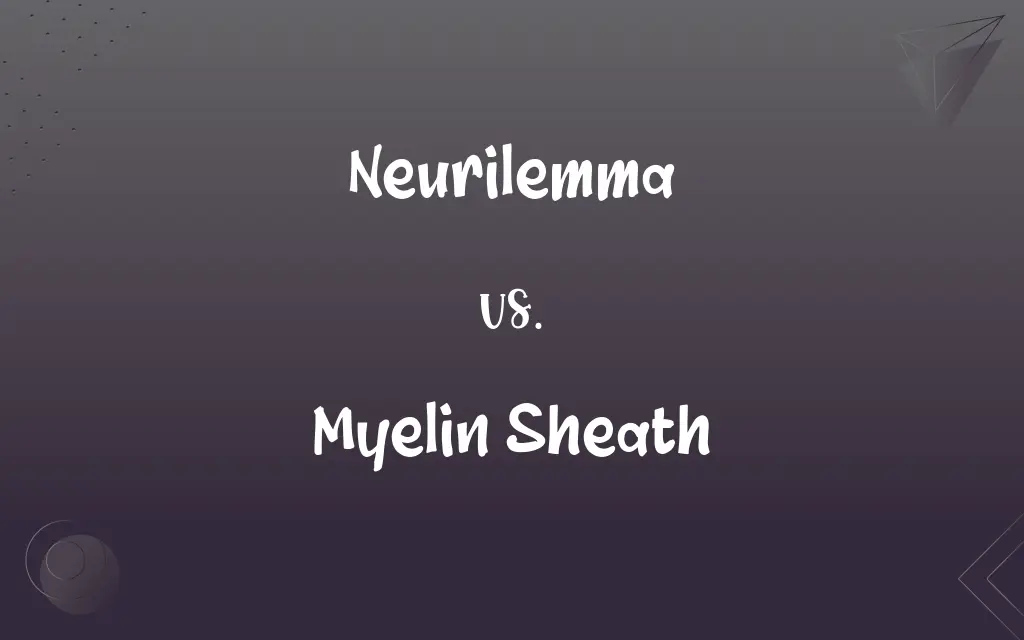Neurilemma vs. Myelin Sheath: What's the Difference?
Edited by Aimie Carlson || By Harlon Moss || Updated on October 9, 2023
Neurilemma is the outermost layer of Schwann cells on peripheral nerves, aiding regeneration; myelin sheath is an insulating layer around nerves, enhancing signal transmission speed.

Key Differences
In a comprehensive lens, the neurilemma manifests itself as a crucial component specifically for peripheral nerve fibers. It is essentially the outermost layer of the Schwann cell, which encompasses the axon of the neuron, and plays a pivotal role in the regeneration of injured axons. On the other hand, the myelin sheath, which can be found in both the central and peripheral nervous systems, serves as a protective and insulating layer around the neuron's axon, facilitating accelerated nerve impulse transmission and preventing the electric current from leaving the axon.
Shifting focus onto the neurilemma, its presence is notably visible only in the peripheral nervous system (PNS). The fundamental purpose it serves revolves largely around regenerating damaged axons, thus asserting its vitality in nerve repair and regrowth. Contrariwise, the myelin sheath is omnipresent, contributing its functions in both the peripheral and central nervous systems (CNS and PNS). Its absence or damage in nerve cells (as seen in conditions like Multiple Sclerosis) can profoundly impede the swift transmission of nerve impulses.
Looking closer at the neurilemma, it presents as an essential player in guiding the regrowth of axons in the aftermath of nerve damage. It enables and directs the axon to its original destination thereby facilitating recovery. The myelin sheath, composed of myelin (a mix of proteins and phospholipids), not only quickens neural transmissions but also saves energy by reducing the amount of active ion transport needed to propagate the action potential down the nerve fiber.
Diving deeper into the anatomical perspective, neurilemma’s physical structure, which constitutes the cytoplasm and nucleus of Schwann cells, is easily distinguishable. It’s this physicality that aids in nerve regeneration post-injury by forming a regeneration tube that directs the growing axon. In contrast, the myelin sheath does not directly participate in nerve regeneration. Instead, it is organized in internodes and segmented by nodes of Ranvier, which are vital for saltatory conduction, allowing the nerve impulse to jump rapidly from one node to the next.
Lastly, when one considers the varied impact that diseases can have on these structures, the importance of both becomes strikingly clear. Damage to the neurilemma can impede its inherent ability to assist in nerve regeneration, while degradation of the myelin sheath, often resultant of autoimmune diseases, severely diminishes the speed and efficiency of nerve impulse transmission along the axon. These disturbances manifest in notable neurological and motor deficits, underlying the pivotal roles that both the neurilemma and myelin sheath play in normal physiological functioning.
ADVERTISEMENT
Comparison Chart
Definition
The outermost layer of Schwann cells in PNS
An insulating layer around axons of nerve cells
Presence in Nervous Systems
Found only in the Peripheral Nervous System
Found in both Central and Peripheral Nervous System
Primary Function
Facilitates axon regeneration and repair
Insulates axons and accelerates nerve impulses
Cellular Composition
Formed by Schwann cells
Formed by Schwann cells (PNS) and Oligodendrocytes (CNS)
Association with Neurological Diseases
Not directly associated with widespread diseases
Associated with Multiple Sclerosis, etc.
ADVERTISEMENT
Involvement in Electrical Isolation
Not involved in insulating nerve fibers
Critical for preventing electrical impulse leakage
Role in Signal Transmission
Does not directly participate in signal transmission
Essential for rapid, saltatory nerve signal conduction
Capability to Regenerate
Can facilitate nerve fiber regeneration
Limited regenerative capability, especially in CNS
Physical Structure
Thin, outermost layer of nerve fibers
Thick, layered structure surrounding nerve fibers
Neurilemma and Myelin Sheath Definitions
Neurilemma
Regeneration Facilitator.
Post nerve injury, the neurilemma forms a pathway, directing the regrowth of the damaged axon towards its original destination.
Myelin Sheath
Neural Insulator.
The myelin sheath wraps around the axon, dramatically boosting the speed at which nerve impulses travel.
Neurilemma
Schwann Cell Envelope.
The neurilemma envelops axons in the PNS, being the outermost layer of the Schwann cell.
Myelin Sheath
Axon Protector.
Encasing the axon, the myelin sheath serves as a protective layer, shielding it from external disruptions.
Neurilemma
Peripheral Nerve Component.
Neurilemma is distinctive to peripheral nerves, providing a structural basis for axon regrowth post-damage.
Myelin Sheath
Nerve Impulse Accelerator.
Featuring gaps known as Nodes of Ranvier, the myelin sheath facilitates rapid, saltatory conduction of nerve impulses along the axon.
Neurilemma
Axon Protector.
While shielding the axon, the neurilemma also plays an influential role in nerve repair and regeneration.
Myelin Sheath
Structure Enhancer.
Myelin sheath provides a structured, segmented covering on axons, optimizing neural communication across nerve cells.
Neurilemma
Neurological Repair Contributor.
In peripheral nerve injuries, the neurilemma acts as a guide, significantly contributing to neurological repair and functional recovery.
Myelin Sheath
Electrical Isolator.
The myelin sheath isolates the axon, preventing electrical impulses from unintentionally diverting to adjacent structures.
Neurilemma
See Schwann cell.
Neurilemma
The sheath that is formed by a Schwann cell.
Neurilemma
The outer membranous covering of a nerve fiber.
FAQs
What function does the myelin sheath perform?
The myelin sheath insulates axons, accelerates nerve impulse transmission, and prevents electrical current leakage.
Why is neurilemma not present in the CNS?
The axons in the CNS are myelinated by oligodendrocytes, which do not form a neurilemma.
Why is neurilemma essential for nerve regeneration?
Neurilemma forms a regeneration tube, directing and aiding the regrowth of damaged axons in the PNS.
Is the neurilemma involved in saltatory conduction?
No, saltatory conduction is facilitated by the myelin sheath and nodes of Ranvier.
What is the relationship between neurilemma and Schwann cells?
Neurilemma is the outer layer of Schwann cells and is instrumental in axon regeneration.
Where is neurilemma located?
Neurilemma is located only in the peripheral nervous system.
Can the myelin sheath regenerate?
The myelin sheath can regenerate in the peripheral nervous system but has limited regenerative capability in the central nervous system.
Which cells form the myelin sheath?
In the PNS, Schwann cells form the myelin sheath, while in the CNS, oligodendrocytes do.
What happens if the neurilemma is damaged?
Damage to the neurilemma can impede its ability to facilitate nerve regeneration and repair.
How does the myelin sheath influence signal speed?
Myelin sheath allows for saltatory conduction, making nerve impulses jump between nodes of Ranvier, increasing speed.
Is the neurilemma involved in insulating nerve fibers?
No, the neurilemma does not insulate but guides regeneration; insulation is the role of the myelin sheath.
What happens to neural communication when the myelin sheath is damaged?
Neural communication can be slowed, disrupted, or blocked, impairing neurological function and coordination.
What is the neurilemma?
The neurilemma is the outermost layer of the Schwann cell, found in the peripheral nervous system, facilitating axon regeneration.
Are there diseases associated with myelin sheath degradation?
Yes, Multiple Sclerosis is a notable disease involving myelin sheath degradation.
How does the myelin sheath support energy efficiency in neurons?
It minimizes ion leakage and reduces the energy needed for impulse transmission.
Can the myelin sheath repair itself after injury?
In the PNS, it can repair and regenerate to some extent; in the CNS, repair is limited and slower.
What cells produce the neurilemma?
Schwann cells produce the neurilemma in the PNS.
How does damage to the myelin sheath affect nerve function?
Damage can slow or block nerve signal transmission, affecting neurological function.
Can neurilemma be found in the brain?
No, neurilemma is exclusive to the peripheral nervous system.
Is the myelin sheath present in all neurons?
No, not all neurons have a myelin sheath; some neurons are unmyelinated.
About Author
Written by
Harlon MossHarlon is a seasoned quality moderator and accomplished content writer for Difference Wiki. An alumnus of the prestigious University of California, he earned his degree in Computer Science. Leveraging his academic background, Harlon brings a meticulous and informed perspective to his work, ensuring content accuracy and excellence.
Edited by
Aimie CarlsonAimie Carlson, holding a master's degree in English literature, is a fervent English language enthusiast. She lends her writing talents to Difference Wiki, a prominent website that specializes in comparisons, offering readers insightful analyses that both captivate and inform.































































